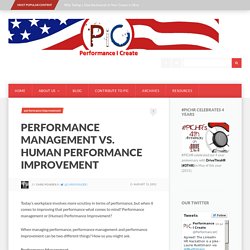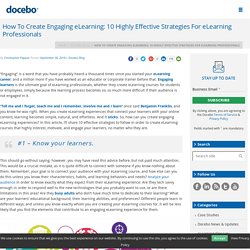

Adobe Spark: Free Visual and Digital Storytelling App. Spock, what is Human Performance? The Performance Improvement Blog. I admire Tony Hseih, not because he built a billion-dollar shoe company that he sold to Amazon, or that he wrote “Delivering Happiness,” a book that has reached #1 on the New York Times Bestseller List, or that he is helping to rebuild downtown Las Vegas.

All of those achievements are laudable. I admire Hseih because he is constantly experimenting in order to keep improving Zappos as an organization and as a place where people want to work and do their best. He has created a culture driven by values and improved through continuous learning. About a year ago, Hseih implemented the Holacracy model in Zappos because he wanted greater employee involvement and commitment. Now, because Hseih believes that Zappo’s employees “…haven’t made fast enough progress towards self-management, self-organization, and more efficient structures…,” he is shaking up the culture again. He wrote in a recent email to employees: They make it a requirement—not an option—to pour one’s heart into one’s job.
Performance Management vs. Human Performance Improvement. Today’s workplace involves more scrutiny in terms of performance, but when it comes to improving that performance what comes to mind?

Performance management or (Human) Performance Improvement? When managing performance, performance management and performance improvement can be two different things? How so you might ask. Performance Management Performance Management is usually referenced as the process of managing performance of an organization, department, or employee. Most people are familiar with performance management with mid-year and annual reviews to determine how well they rated against their established goals. Performance Improvement - more than just a change in behaviour. How To Create Engaging eLearning: 10 Effective Strategies. “Engaging” is a word that you have probably heard a thousand times since you started your eLearning career; and a million more if you have worked as an educator or corporate trainer before that.

Engaging learners is the ultimate goal of eLearning professionals, whether they create eLearning courses for students or employees, simply because the learning process becomes so, so much more difficult if their audience is not engaged in it. “Tell me and I forget, teach me and I remember, involve me and I learn” once said Benjamin Franklin, and you know he was right. When you create eLearning experiences that connect your learners with your online content, learning becomes simple, natural, and effortless. And it sticks. So, how can you create engaging eLearning experiences?
#1 – Know your learners. This should go without saying; however, you may have read this advice before, but not paid much attention. . #6 – Make your eLearning course visually appealing. When using Bloom’s Digital Taxonomy (a revised take on Bloom’s devised by educator Andrew Churches), it helps to have a list of verbs to know what actions define each stage of the taxonomy. This is useful for lesson planning, rubric making, and any other teacher-oriented task requiring planning and assessment strategies.
The Bloom’s Digital Taxonomy verbs in this handy infographic apply specifically to each stage of the taxonomy. They progress from LOTS (lower-order thinking skills) to the HOTS (higher-order thinking skills). According to Churches on his wiki Edorigami, “Bloom’s Revised Taxonomy describes many traditional classroom practices, behaviours and actions, but does not account for the new processes and actions associated with Web 2.0 technologies …” This means the verbs listed below are applicable to facilitating technology use in the modern classrooms. When I received the invitation from the new Lee Kong Chian School of Medicine at the Nanyang Technological University in Singapore, I decided to completely upgrade two seminar workshops.

Dr Ian Green from the School of Education here at Adelaide and I have used Padagogy101 (introduction to iPad in HE) and Padagogy201 (more advanced use for L&T) to train over 600 faculty from universities in Australia. For Singapore, Ian wasn’t going to be with me and I was solo, as well I needed a better way to leave resources in place for people to revisit. However I was completely surprised at what else happened. During my research I saw lots of great work done by others using Bloom’s Taxonomy including the Revised Taxonomy which has now become the Bloom’s Digital Taxonomy. However when I discovered the excellent pioneer work done by Kathy Schrock with “Bloomin’ Apps” I got the idea for the Padagogy Wheel. I have added 62 iPad apps to the wheel and put them where they could serve the pedagogy. Hpi11. Human Performance Improvement. Human Performance Improvement.